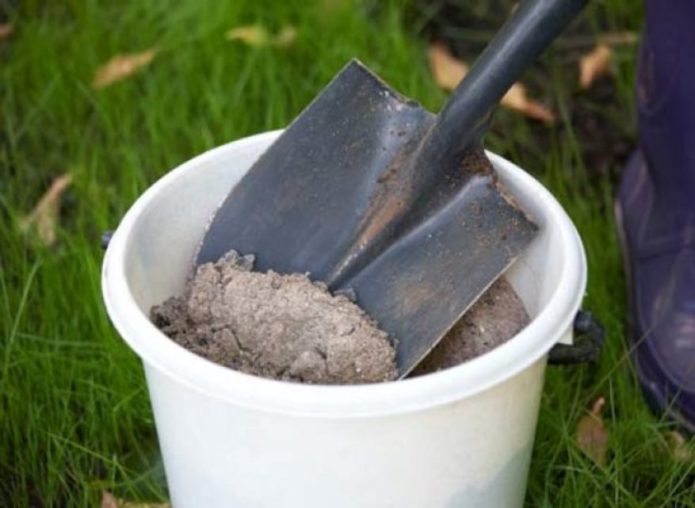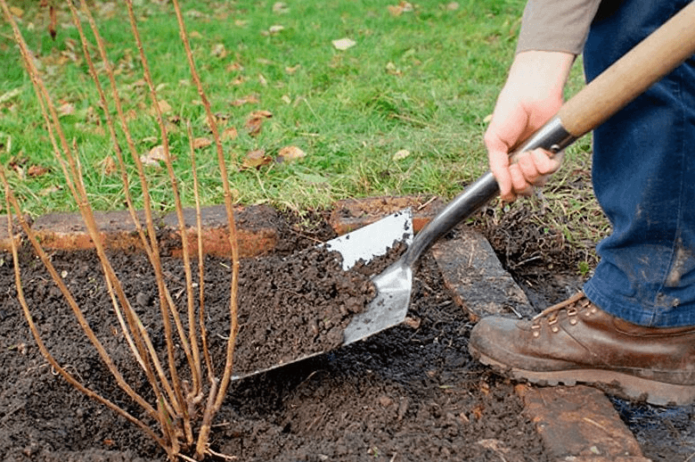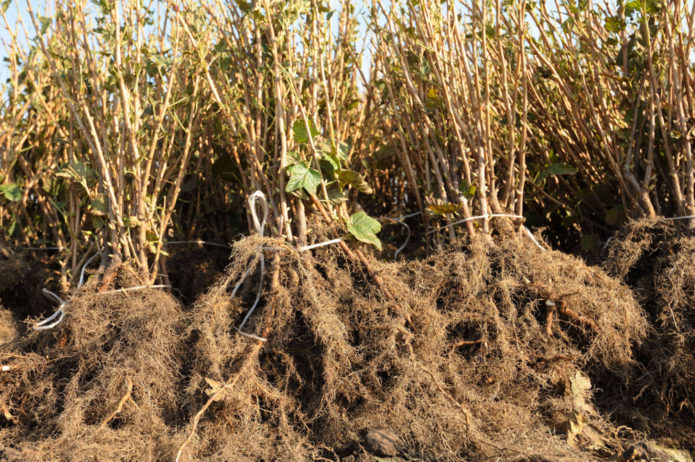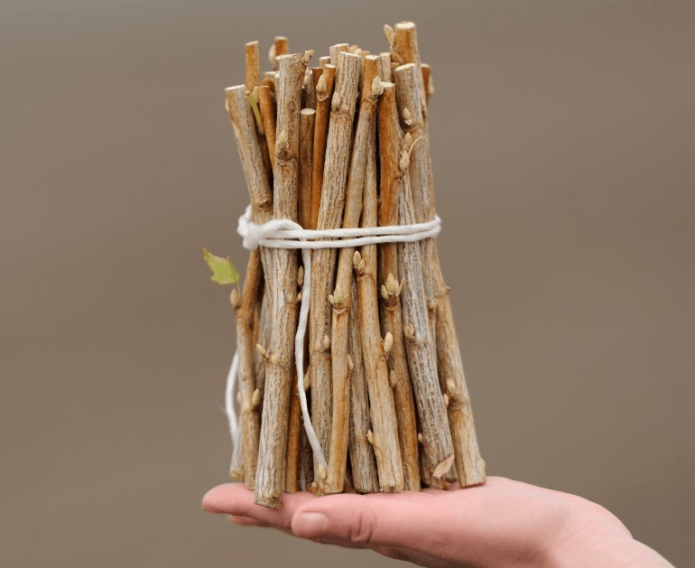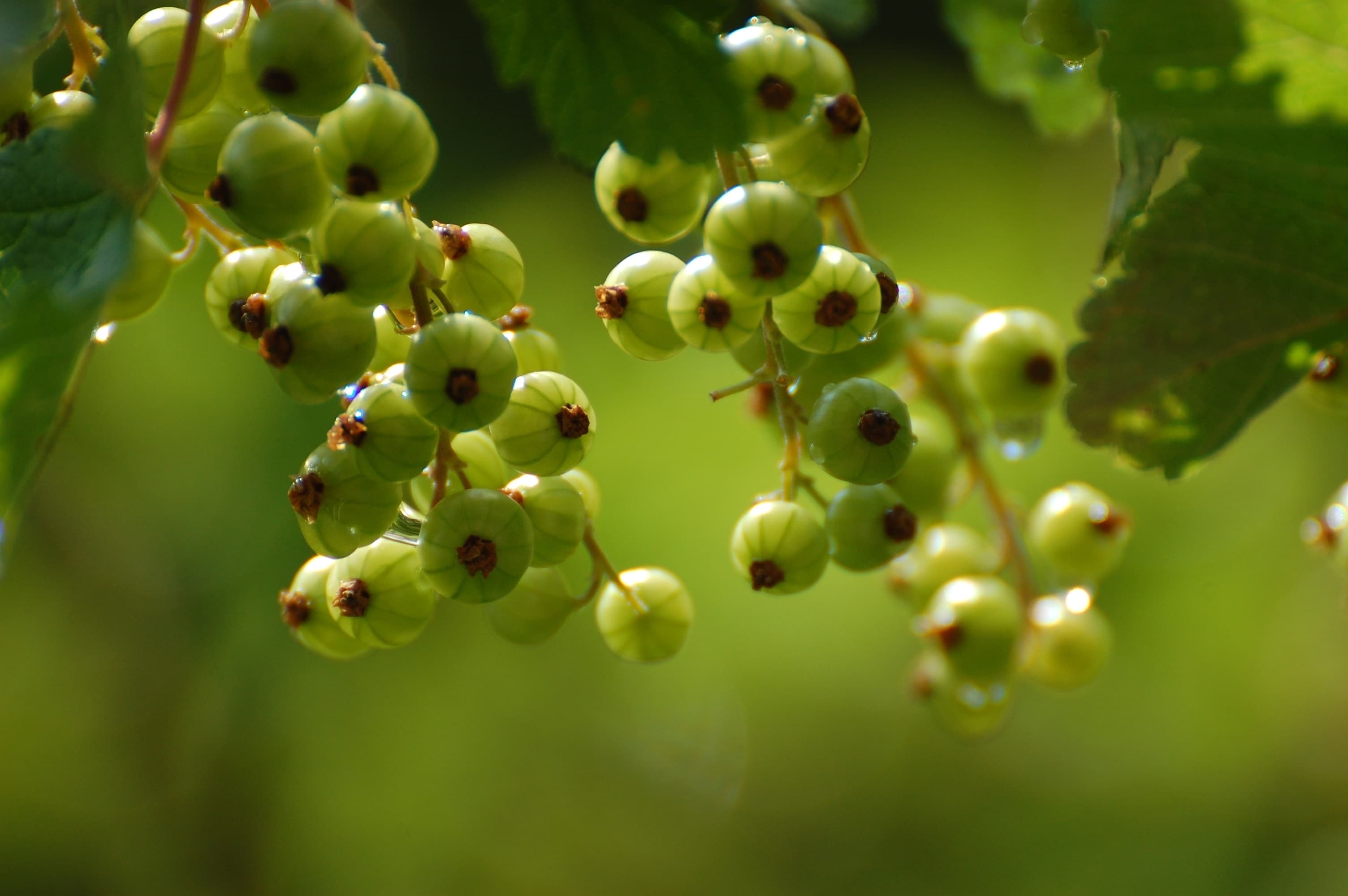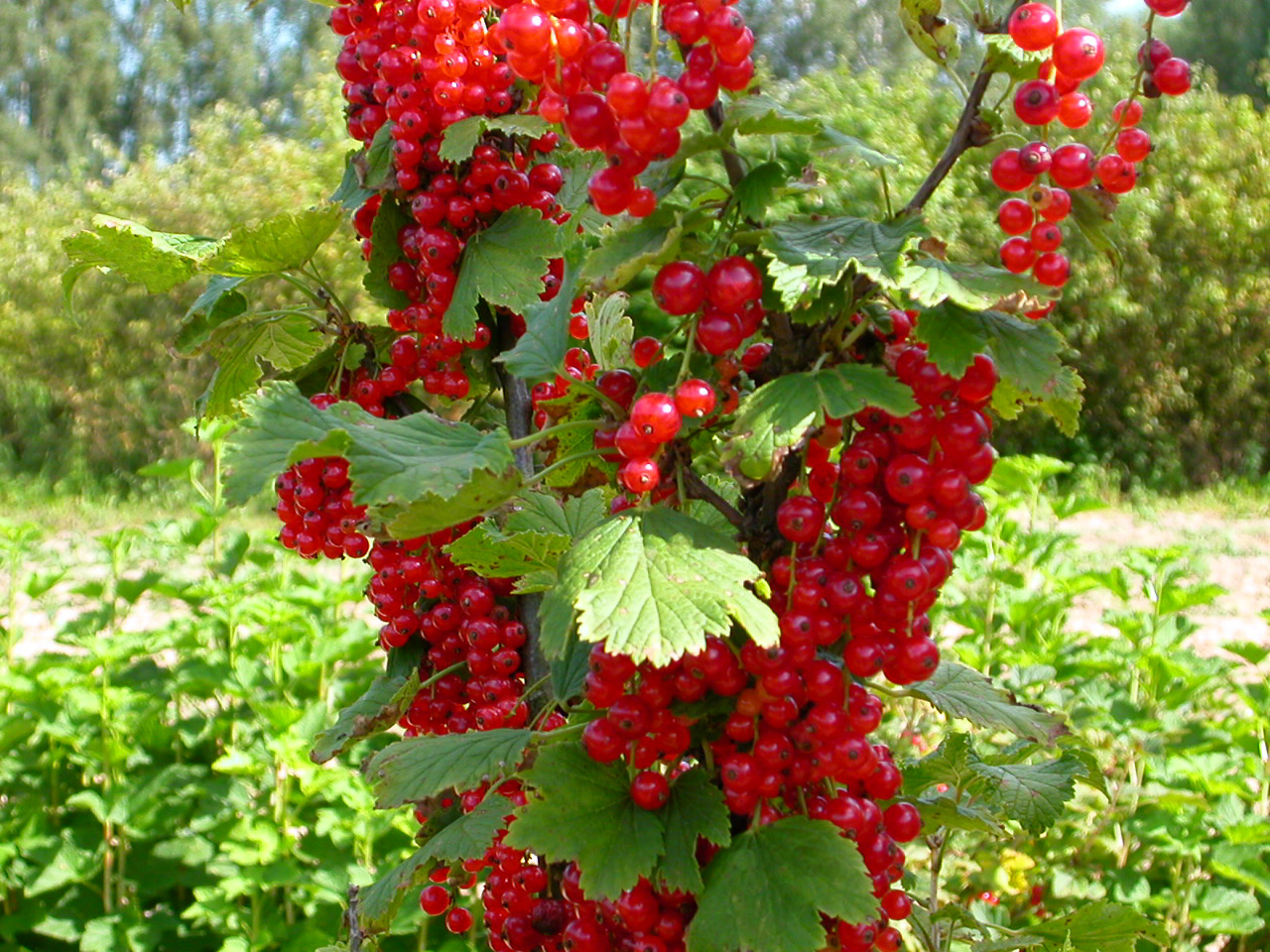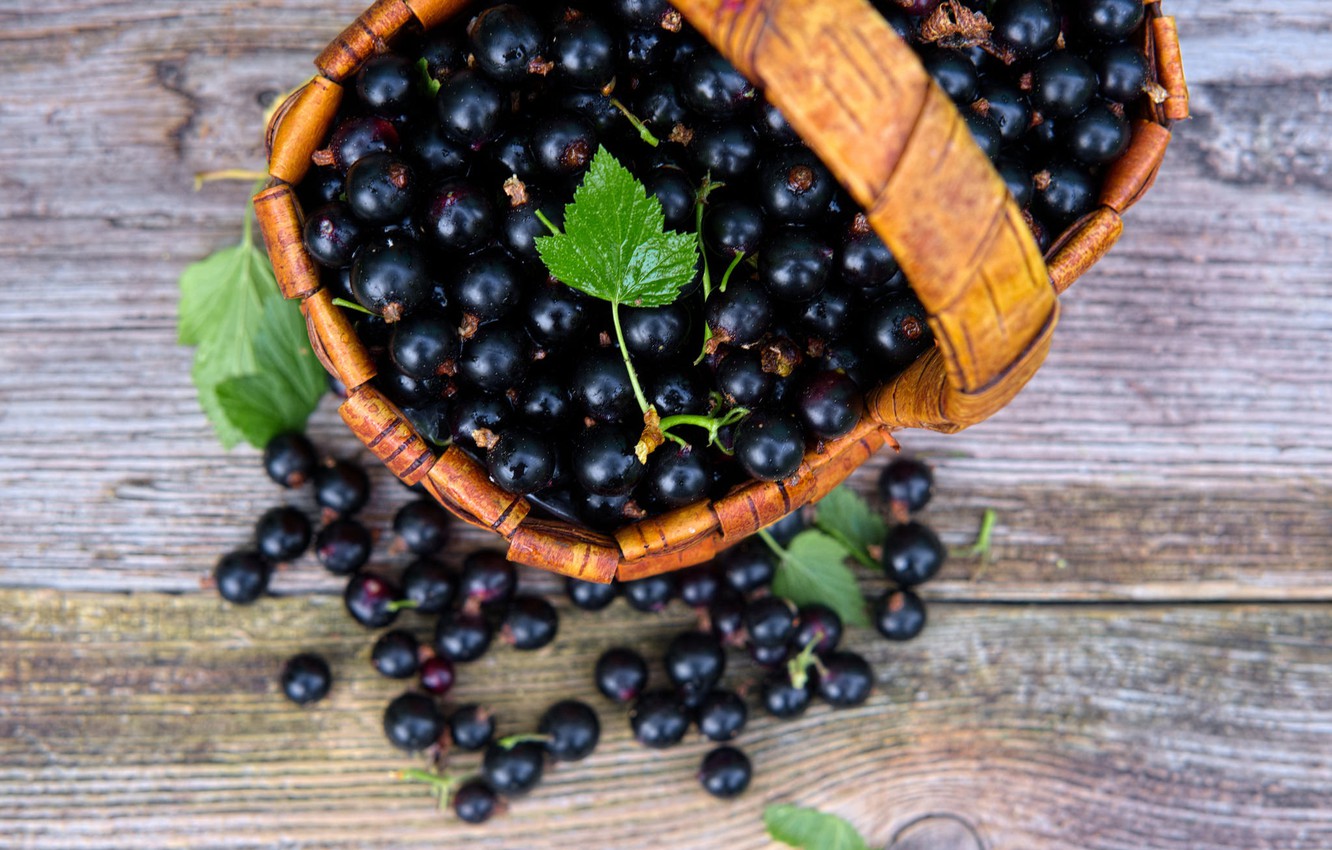To get a good harvest, it is important to follow the planting and care technology. Experts say: it is better to lay the future harvest before winter. What is so good about planting currants in the fall and how to plant it correctly.
Why currants need to be planted in the fall
Currants should be planted in the fall, as they bud in early spring. And if you plant a crop around April, then you can not wait for berries in the same year with a probability of 99%. As long as the bush takes over and turns green, there will be no time left for the formation of the ovary and the ripening of the bunches.
The main advantages of planting before winter:
- quick adaptation of the culture to the soil and rooting;
- absence of pests in the soil;
- timely revival in spring, the appearance of foliage and ovaries.
Consider the difference in planting black currants and red or white: the former loves slightly acidic soil, well moisturized in the lowlands, and the latter prefer less moisture, lack of acidity and higher places.
It is important to remember: when planting in autumn there is always a risk that the seedlings or cuttings will freeze during the fierce winter. Therefore, it is recommended to cover the bushes until spring, just in case. For this, dense spunbond or spruce legs are suitable.
Dates and geography of planting: table
The main rule here is to give time to the bushes to take root, take root and prepare for wintering. It will take about 20 days for black currants, and about 25 days for red and white currants.
| Geography | Boarding time |
| Moscow and Moscow region | second part of September - October |
| Middle zone of Russia | |
| Leningrad region | end of August |
| Ural | |
| Siberia | |
| South of Russia | second part October - mid-November |
How to prepare a site for planting
Since it is assumed that black currant bushes will live in one place for 10 years, and red or white for all 20, places for them should be chosen responsibly.
Plant a black currant bush in a more acidic and moist soil and get as a result:
- good plant development;
- high fertility;
- lack of barren flowers;
- large and juicy berries.
In less acidic soil on a hill, identify red or white currants.
Wind protection is important for all varieties.
Black currants do not like shade, red and white ones tolerate it more or less normally, but they also need the sun.
Good predecessors for planting currants are cereals, annual herbs. The bad ones are raspberries, gooseberries.
Fertilizers
Manure and compost are considered good fertilizers. You can use both at the same time: put in the seedling hole.
The fertilizers applied for planting must be mixed with the ground or at least sprinkled so that the roots of the plant lay on the ground and do not burn out from direct contact with the fat.
If you need to deacidify the soil (in the case of red and white currants), use chalk or old cement. Crushed eggshells will also work.
Many bring ash when planting. But this is an ineffective measure in the fall: the calcium brought in by the ash is quickly washed out by the rains from the top layer of the soil, like nitrogen fertilizers. Therefore, when planting before winter, add only double granular superphosphate - 2 tablespoons under each bush. Everything else is in the spring.
Planting in acidic soil
At the planting site, remove a layer of soil 40 cm thick, mix it with dolomite flour at the rate of 0.5 kg per 1 sq. m and pour the mixture back to where the soil was removed from, and then fertilize with mineral additives.
Preparing planting material
You can plant currants with seedlings or cuttings. The first method is easier: you can buy seedlings and plant them right away. But only if you are versed in this matter and can easily choose a good planting material.
Saplings
The main criteria for choosing seedlings:
- they should not have broken off roots and cuts;
- the plant has two or more shoots;
- it has a hairy, woody root.
Cuttings
The situation with cuttings is more complicated. Of course, it is also better to buy them from reliable sellers, since ideally the mother bushes are specially grown, monitored, and protected from diseases. According to the rules of propagation of currants, nothing else should grow within a radius of 1.5 km from the mother plantations. However, on a personal plot, it is unrealistic to follow this rule. But it is quite possible to grow a healthy bush in order to then take high-quality cuttings from it.
The algorithm for planting cuttings is as follows:
- Annual shoots at least 7 mm thick must be cut 20 cm long with a sharp tool. The upper cut is made 1 cm above the kidney, the lower, oblique, under the grafting site.
- Soak the shoots in water for 5–7 days, during this time the liquid must be replaced twice.
- Soak the cuttings for another day in a solution of heteroauxin.
When propagating by cuttings, the shoots of others must first be grafted onto existing plants. And after a year, take cuttings for planting in the ground.
Step-by-step planting instructions
Planting currants in any way is best done together: one is holding a seedling (cutting), the other is dropping it.
Saplings
The landing technique is as follows:
- Dig a hole 30 cm deep and 40 cm by 40 cm.
- Apply fertilizer to three quarters of the depth, mix them with the soil.
- Plant the bush at a 45-degree angle, fan out the shoots.
- Sprinkle earth over the roots, compact it around the seedling.
- Make a watering groove around the plant.
- Pour a bucket of water into the groove.
- After the water has been absorbed, sprinkle the trunk around with peat or dry sand.
- Cut the shoots to such a level that 3-4 buds remain above the ground.
Currants are a self-pollinated crop, but cross-pollination will only benefit, so place inter-pollinated varieties in the same row.
Cuttings
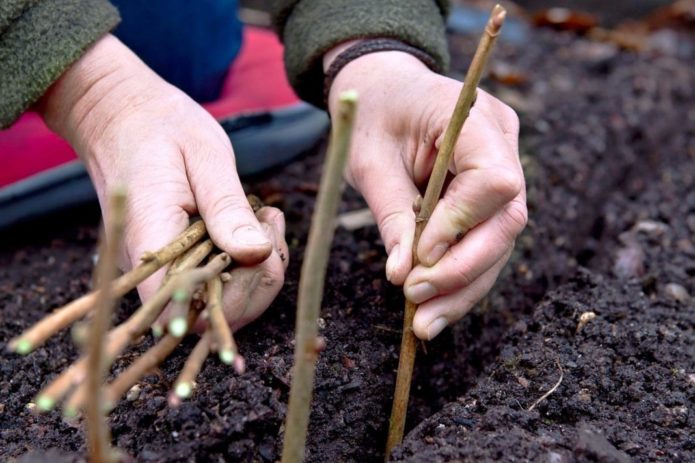
First, a lace is pulled on the prepared area, along which the currants are planted in a couple of lines, leaving about 20 cm between them, and 40 cm between the rows, the plants should be at a distance of about 10-15 cm from each other
The landing procedure is as follows:
- Dig small holes about 20 cm deep.
- Add fertilizers, mix them with the soil.
- Place the stalk at a 45-degree angle in the hole and sprinkle with earth.
- Compact the soil around the cutting. 2-3 buds should remain on the surface.
- Make a groove around the stem and water liberally - about half a bucket per plant.
- Mulch the ground around with humus or peat in a layer of 3-5 cm.
In the spring, the cuttings that have taken root are transferred to their "permanent residence", in the fall they form full-fledged bushes, which begin to bear fruit next summer.
Currant care
A young plant requires special attention. The soil around it should be covered with a 10 cm layer of compost, peat or humus.
To prevent a crust from appearing after watering, sprinkle the ground near the bush with sand. Before frosts, spud the plants, and in the spring, remove this soil from the trunks.
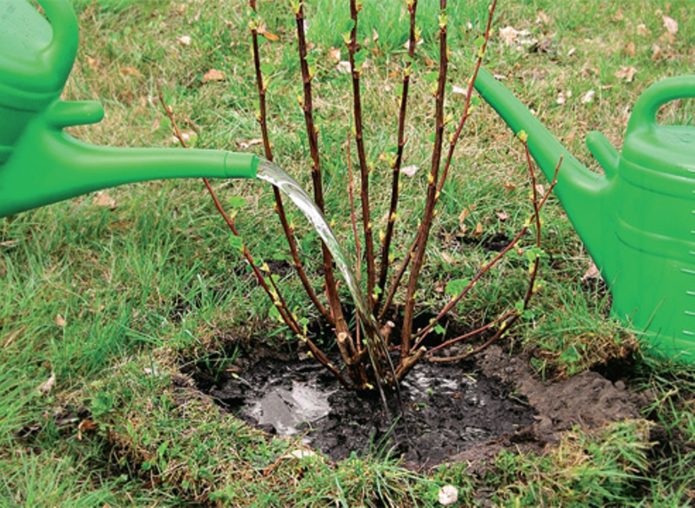
You need to water it with plenty of warm water, if the autumn is not rainy, especially black currant
Cover the cuttings with spunbond or gauze after planting. Can be spruce branches. Water liberally for the first couple of weeks. Then you can gradually accustom them to the cold - open them, and gradually leave them without shelter. Can be fed with nitrogenous mineral fertilizers.
Observing the simple rules for planting currants in the fall and caring for the crop, you can guaranteed to get a good harvest in the summer.

